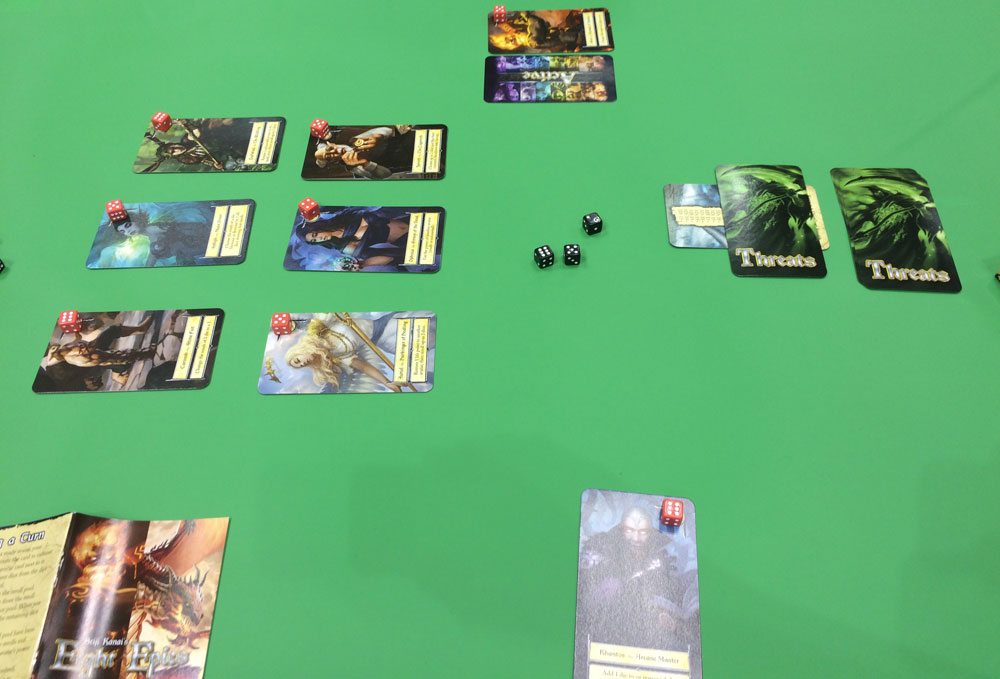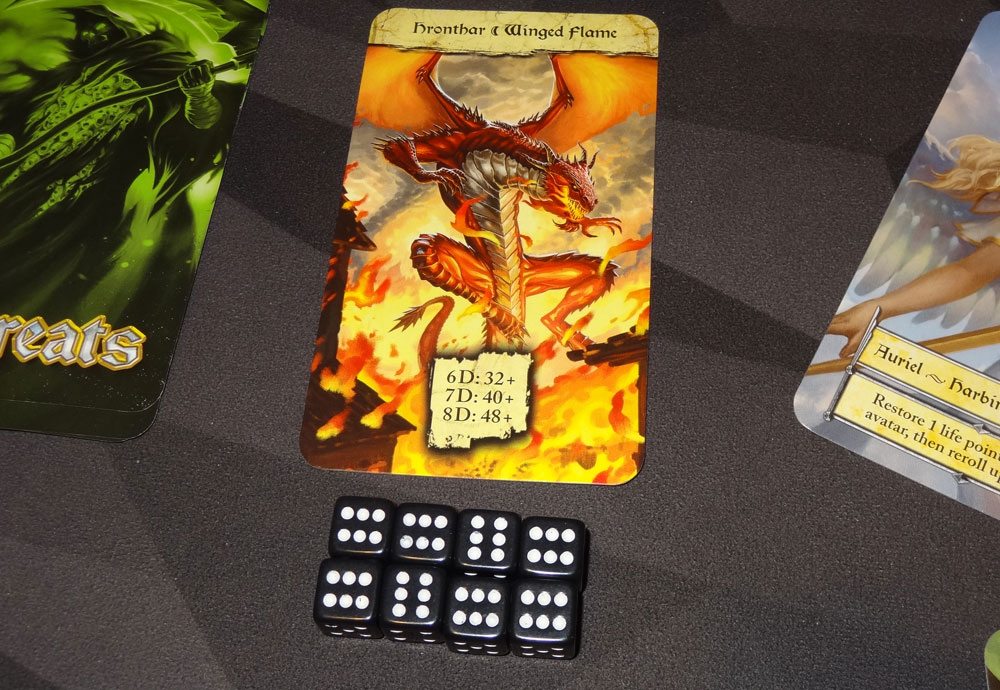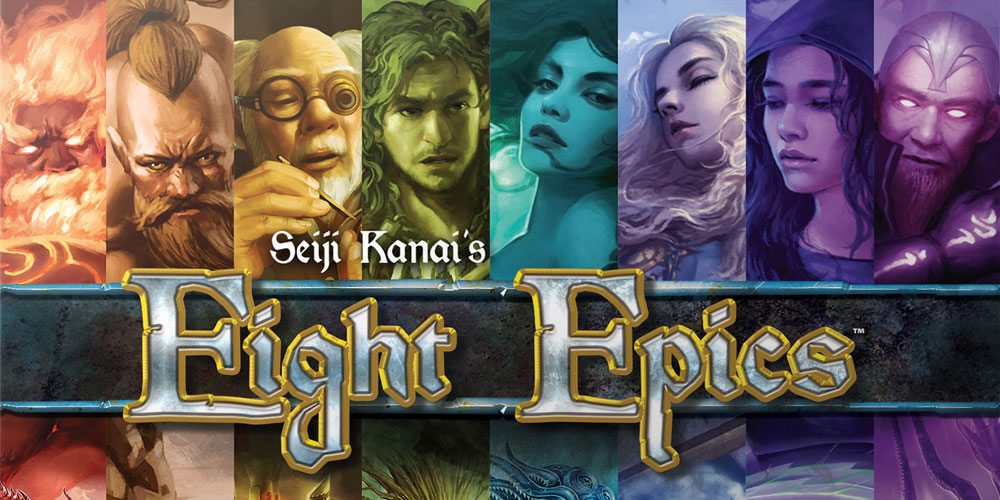Seiji Kanai is perhaps best known for Love Letter, a game that manages to contain a surprising amount of strategy in only 16 cards. Eight Epics is one of his new releases this year, a cooperative game about saving the world from destruction. Eight powerful Avatars of Hope, mortal champions who have been blessed with powerful abilities, are reincarnated every 40 generations in Elzarr. They are sent to face the eight Avatars of Woe, who threaten the world with destruction. The Avatars of Hope have always triumphed in the past—but will they save Elzarr this time?
At a glance: Eight Epics is a cooperative game for 1 to 8 players, ages 14 and up, and takes about 30 minutes to play. It is published by AEG and retails for $19.99; it is available now in game stores and from Amazon. The game can be played by younger players, though probably best with a more experienced player involved. There are some creepy-looking monsters on some of the cards, but nothing more graphic than other fantasy games. The gameplay involves getting the right combination of dice for each threat using a combination of luck and dice manipulation with powers.

Components:
- 8 Avatar cards
- 9 Threat cards
- 12 Event cards
- 1 Active Avatar card
- 8 red dice
- 12 black dice
All of the cards are tarot-sized, so there’s plenty of room for large artwork, and fortunately the text is legible. The threat cards use a sort of shorthand to indicate how to resolve them, and you’ll be referring to the rulebook frequently for those because they’re not entirely intuitive. However, after a few plays, most will make sense without having to check the rulebook. I do wish that, for the cards that have several identical lines of text, that they had put some sort of markers so that they’re easier to count.
The artwork is nice, with full-color illustrations for the avatars and threats, and scroll-like illustrations for the event cards. The dice are 12mm six-sided dice, nothing particularly fancy. The whole thing comes in one of AEG’s small boxes, making it pretty portable.
How to Play
You can download the rulebook here.
The goal of the game is to defeat all of the epic threats as a team before all of the avatars run out of life points.

To set up, each player takes one of the avatar cards and places it in front of themselves; all unchosen avatars are placed in the center of the table as common avatars. Place a red die on each avatar card, with its value matching the starting life points shown on the card. Remove the Witch Trials threat card (that’s for a variant) and shuffle the rest of the threat cards to form a threat deck, and then remove 2 at random and return them to the box.
Turn the top threat face-up as the active threat. Each threat card has a number of challenges that must be resolved in order, and each challenge indicates how many dice should be rolled and placed in the dice pool. For instance, “6D” means that the players must meet the challenge using 6 dice.

There are various types of challenges: some have a minimum total you must reach with the dice pool, and some have a maximum total so you have to roll as low as possible. Some have specific target numbers for the dice, or you might need all of the dice to be the same number. The Serrin threat is special: you start with eight dice showing “6” on each die, and you must make them all “1” for the first challenge. The second challenge is reversed: start with eight dice showing “1” and turn them all into “6.”
The game takes place over 5 rounds, though within each round each player may have more than one turn.
When it’s your turn, you first select an avatar, either yours or a common avatar, and place the “active avatar” card next to it. Rotate the selected avatar card to indicate that it is exhausted. You may not select an avatar that is already exhausted. If there are no avatars available for you to use, your turn is skipped.
Then you enter the reroll phase. You may choose up to three dice from the dice pool to reroll. Roll the selected dice. Then, choose at least one to place back into the dice pool, and roll the rest. Continue this until all of the selected dice have been returned to the dice pool (so at most you will get three rerolls, if you selected three dice and only put one back each time).
You may then spend life points from the active avatar to take another reroll phase—decrease the red die, and then repeat the reroll phase. You may also spend the avatar’s life points to activate its special ability. Each avatar has its own unique ability. You may spend as many life points as you wish, but once the avatar has no life points left, you must stop, and the avatar will be returned to the box at the end of your turn.

Each avatar has its own unique ability:
- Auriel: Restore 1 life point to another avatar.
- Jarroth: Choose up to 2 dice to flip over to their opposite faces.
- Leafwind: Return 1 avatar to its ready state, and then reroll up to 2 dice.
- Sylliph: Choose a number, and increase or decrease all dice with that value by 1.
- Khantos: Add or remove 1 die from the pool.
- Gron: Change one die to a 6.
- Caroosh: Change one die to a 1.
- Ophinia: Use the power of another avatar.
If you fulfill the requirements for the current challenge, then you resolve the challenge: immediately proceed to the next challenge and roll a new set of dice for the dice pool. (Use an extra die or provide your own tokens to keep track of which challenge you’re currently on.) You then go back to the “spend life points” phase of your turn—you do not get to select a new avatar, and you do not get the free reroll phase. If you successfully defeat the last challenge on a threat card, the round ends.
If at any time you are done spending life points and have not yet fulfilled the requirements for the current challenge, you end your turn: pass the “active avatar” card to the next player. The dice pool remains the same and is passed to the next player as well. If any avatars have zero life points at the end of your turn, they are removed from the game. If you end your turn and all avatars are exhausted or have been removed, the world ends and everyone loses. (Note: if your avatar is removed, you’re still in the game, but you may only choose a common avatar on your turn, if available. In an 8-player game, however, there are no common avatars.)

When a threat is totally defeated, the round ends: the threat is discarded and placed to the side. All exhausted avatars are returned to their ready state, and then draw the next threat card. The active player must end their turn now.
During the fifth round, you reveal both of the remaining threats. These two threats must be defeated in one round, without the benefit of refreshing exhausted avatars in between threat cards. The active player starting the fifth round may decide which threat to attempt first, but the team must defeat that threat before attempting the other.
The game ends either when all threats have been defeated, or when all avatars have been defeated.
The rulebook also includes instructions for increasing or decreasing the difficulty of the game and playing a solo variant. There’s also an event variant: each round, you draw an event card to accompany the threat, which will describe some limitations for the avatars. However, when you overcome the threat, you gain additional abilities as a reward.

Finally, the Lost Witch scenario is a special event variant. You shuffle in the Lost Witch scenario card into the event deck, and you start the game without Ophinia. When the Lost Witch card is drawn, the Witch Trials threat becomes the active threat. Ophinia is added as a common avatar after the Witch Trials threat is defeated, or after the end of the fourth round (whichever is sooner).
The Verdict
Eight Epics is a little bit like playing Yahtzee, but it’s cooperative, and with special powers, and the world will perish if you lose.
Okay, so maybe it’s not quite like Yahtzee.

Let me try that again: Eight Epics packs a whole lot of terrible bad guys into a little, unassuming package. You open it up and think, hey, that’s some cool artwork. Hmm, there are some numbers and letters on this card—I guess that’s how you defeat the threat. Okay, let’s try this… And then a few minutes later, you’re pulling your hair wondering how you’re going to get 7 dice to total 9 or less. And when you succeed at that, you need to get 8 dice to total 8 or less. Good luck!
The game requires a mix of luck and strategy. Luck, of course, because you’re rolling a lot of dice and trying to get them to conform to a particular result. The strategy comes into play when you’re deciding which avatar to use and how to spend its life points. Buying a reroll with a life point will allow you to reroll up to three dice, but using the avatar’s special ability often gives you more control, though potentially with fewer dice.

Each of the avatars pairs up well with one of the threats (as seen on the cover of the box). For instance, Gron’s ability to turn dice into 6s is the most helpful against Hronthar the dragon, who requires very high totals. But he’s useless against Durge the meteor, who requires a series of very low rolls. For Sylliph’s power to be most effective, you want a lot of dice showing the same number, because she changes all of them at once.
It’s also important to know when to end your turn and pass to the next player, because each player gets one free reroll action without spending life points. However, each time a turn passes, another avatar is exhausted unless you can defeat the current threat—and if you run out of avatars, the game ends. So, basically, you have about 8 turns (one per avatar) to complete each threat. Of course, with Leafwind’s ability to refresh avatars, you can squeeze a few more turns out of it when necessary, but there’s a ticking clock for each card. It’s a tricky balance to maintain, defeating the threats in time without spending too many life points.
The game has a different feel depending on the number of players you have. When you have fewer players, there are a lot of common avatars and you have more control over the order that you activate avatars. If you have more players and fewer common avatars (or none at all), then the turn order of the avatars is less malleable, and sometimes you may be stuck with an avatar-threat pairing that just isn’t ideal. (In the solo game, you must pick an order for your avatars at the beginning, and stick with that order throughout.)

The events are pretty crazy: while they’re active, you have some severe limitations—only using your power once per turn, or having to spend two life points to use your power, or even immediately defeating an avatar and removing it from the game! When—or if—you defeat the threat, the event card then becomes a one-time-use ability. The abilities are powerful, to be sure, but I think including the events definitely increases the overall difficulty of the game.
The theme of the game doesn’t feel closely tied to the mechanics—you don’t have any sort of feel for what the dice represent, or how getting certain values defeats these epic threats, even if you read the provided lore in the back of the rulebook. They feel more like a series of abstract mathematical tasks, particularly when you’re adding up eight dice and trying to make sure they’ve reached a certain threshold. It’s a little more abstract than I usually prefer, but the dice-matching requirements can be a fun puzzle. However, even with the thematic disconnect, there’s still a palpable tension with each roll of the dice, and I can attest that there were often enormous cheers when a player managed to roll exactly the number we needed without having to spend life points for rerolls or to change the dice.
The game is fairly difficult (with options, of course, to make it even more difficult, like prohibiting any table talk after the first couple rounds) so you will need a good amount of luck no matter what your strategy. I do think the game would be incredibly difficult without the ability to discuss strategy, but at the same time, shutting down the table talk would help prevent the alpha player problem, where one person basically takes over and directs everyone else’s turns.
Eight Epics probably won’t unseat popular bigger-box cooperative games like Pandemic, but Love Letter wasn’t a replacement for bigger strategy games, either. Rather, they’re both small games that may surprise you with their depth, and once again Seiji Kanai shows that he can do a lot with a little.
In short: if you like tough cooperative games and rolling dice, Eight Epics provides a nice challenge in a portable package.
Disclosure: AEG provided a review copy of this game.





